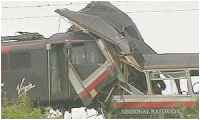|
|
|
|
|
|
|
|
|
|
|

 Engineers clear crash line BBC Online 24/06/99  Crash train 'ran past red signal' Yahoo/Independant 24/06/99  Driver's prompt action saves lives The Times 24/06/99  Investigation starts into Cheshire train crash ITN 23/06/99  Driver 'averts disaster' BBC Online 23 Jun 99  Yahoo! News - Full Coverage: Dozens Hurt in UK Rail Crash 
 Pall cast over rail safety : ITN reports ITN 23/06/99  Unsafe signals fear Report 25/01/99  Virgin Trains Corporate Website  Railtrack 
 Seven days . . . . . . web focus on rail safety and accidents in the last week |
||||
UK: Missed danger signal said to have caused Virgin Trains crash: Thursday, June 24, 1999A train which passed a danger signal caused the accident between a speeding Virgin Trains express and a
According to reports today, the driver of an empty First North Western train realised that he had passed a red signal and reported the SPAD (Signal Passed At Danger) to the control centre. However, his train had already passed onto the fast line and the warning was received too late to warn the 110 mph express of the danger. The driver of the Virgin London - Glasgow express is being praised for his quick reactions in preventing a much more serious incident. The driver, Roy Eccles (56) spotted the train ahead of him and made an emergency brake application slowing the Virgin train to about 50 mph at the moment of impact. Richard Branson, founder of the Virgin Group has visited Mr Eccles in hospital where he was being treated for minor injuries. The trains involved were the Virgin Trains 0635 London Euston to Glasgow Central service which was headed by a class 87 locomotive No 87027 'Wolf of Badenoch'. The FNW train consisted of 2 class 142 "Pacer" units Nos 142008 and 142003. The train was empty, travelling from Crewe to Manchester. Thirty-one people were injured in the first four carriages of the express train which were derailed. The train's locomotive overode the underframe of the rear Pacer unit and entered the passenger compartment. The roof was split from the body sides which were severely damaged. The class 87 suffered considerably less damage and the driver escaped with minor injuries.
Investigations There are several possibilities that investigators will examine. Was there a signalling fault? This may have given a driver a false indication so causing the conflicting train movement. Was it human error? It is possible that a driver may have misread a signal. The HSE inquiry is likely to examine the issue of Automatic Train Control (ATC) - a system that could stop a train automatically in the event of it passing a signal at danger - but not widely implemented on Britain's railway network. A Railtrack spokesman told the media that it was hoped that the cause of the accident would be known "in a few weeks". The result of the HSE's investigation is likely to take considereably longer. The inquiry into the accident at Southall in December 1997 has been adjourned pending criminal prosecutions and is not scheduled to restart until September this year. Earlier reports: Virgin Trains high speed train crash - 23/6/99
Comment on this item... |
|
|
